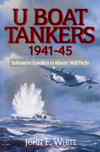U-Boat Tankers, 1941-1945
White, John F.
1998, United States Naval Inst.
ISBN 1557508615
250 pages
| Type. | Historical narrative |
| Pros. | Very detailed and comprehensive |
| Cons. | Sometimes confusing |
| Rating. |  |
 The title of this book notwithstanding, the large U-Boat supply tankers (commonly known as "milk cows") suckled more than just the Atlantic wolf packs, and author John White does a yeoman's job in telling their remarkable story.
The title of this book notwithstanding, the large U-Boat supply tankers (commonly known as "milk cows") suckled more than just the Atlantic wolf packs, and author John White does a yeoman's job in telling their remarkable story.
According to White, Germany is the only country in history to have operated submarine tankers, a circumstance generated by the necessity of refueling U-Boats in distant theaters of war. Initially, Germany relied on surface suppliers, such as Atlantis and Python. Decryption of the German codes, however, allowed the Allies to find and dispatch them with relative ease. Although U-Boat Command (BdU) appreciated that something was amiss, Admiral Karl Dönitz refused to believe that the codes had been broken. It was a mistake that would haunt German resupply efforts with fatal consequences.
The loss of the surface supply vessels in late 1941 caused Dönitz to rely on three new types of U-Boats, all of which were working up in the Baltic: the type XIV tanker (Milk Cow), XB minelayer, and the type IXD2 cruiser. The IXD2 was a large and unwieldy boat unsuited for nimble hit-and-run convoy actions, but a perfect fit for lone sorties in distant waters, as was the 1,763-ton type XB minelayer. The XIV tanker, whose story forms the nucleus of this book, carried only anti-aircraft guns for defense, using the extra room otherwise taken up with torpedoes to carry 700 tons of oil to refuel boats at sea. The primary advantage of refueling attack submarines with submarine tankers was the ability of the latter to submerge and remain hidden for long periods of time. Their presence allowed front line U-Boats to exhaust more fuel in search of enemy shipping knowing that a mobile fuel source would be available for the long journey home. The results, for a time, tilted the Battle of the Atlantic in Germany's favor.
U-459 and U-460 were the first of six type XIV boats built in the last quarter of 1941 and sent to sea. (Four more boats, U-487 - U-490, were constructed in 1942-43.) They were fabricated from sections of a IX boat, but an extra tank around the hull made them fatter and slower. They displaced 1,688 tons (compared to 1,120 for a IXC), their diving time was slow under the best of circumstances, and their large size made them easier to detect underwater. In addition to oil, the tankers carried important spare parts, food, ammunition, and extra torpedoes.
Unlike other writers who have touched on the subject, White does a good job describing the tedious task of refueling boats at sea. Simply finding the boat to be replenished was often laborious and always dangerous. The refueling operation itself was fraught with peril. Tanker crews bobbed on the swells of the sea with giant hoses connected to the feeding U-boat, hatches open and unable to dive quickly if the necessity arose. Rough seas and bad weather compounded the problem, and men were often swept off boats during the operation. Still, the milk cows made long patrols in distant theaters (the United States and the Caribbean, for example) both possible and profitable. In addition, their abilities to resupply numerous boats at sea sustained lengthy wolf pack actions against convoys. Unfortunately for Germany, after the middle of 1943 virtually every tanker was resting on the bottom of the ocean, the victims of superior Allied direction finding equipment and broken codes.
In addition to a complete history of how Germany utilized submarines for resupply at sea, U-Boat Tankers contains two galleries of remarkable photographs depicting a number of refuelings. One of these is a picture of U-847 refueling U-172 in August 1943. Just hours later, U-847 was lost with all hands when a Fido dropped from the sky tracked her down underwater and sent her broken hull spiraling to the bottom. Six appendices complete White's effort. Although U-tankers were ordered to avoid contact with the enemy at all costs (most did not carry any offensive weapons), they did score several successes at sea, mainly as a result of their heavy anti-aircraft armament. A valuable appendix tabulates these results by boat number and type, and lists ships sunk and damaged by mines deployed by XB minelayers. Other appendices record Spanish cooperation with the Germans, a list of known war cruises (the average length of which was 60-90 days), the various types of U-Boats described in the book, a U-Boat quadrant map, and German naval ranks.
Their are a few minor criticisms. U-Boat Tankers is not footnoted, although its bibliography makes it clear it was based on war diaries and firsthand accounts by former crewmen. White's prose style is straightforward but occasionally clumsy and difficult to follow. He inconsistently references boats by their number (U-459) and commander's name (von Wilamowitz-Moellendorf), which often leads to confusion since their are so many boats being described simultaneously. The overlapping time line method of organization also muddles White's effort.
Although U-Boat Tankers provides a good foundation for understanding the German refueling effort at sea, the author failed to humanize the men who crewed these boats. White does a wonderful job detailing the logistics of the operations and the characteristics of the tankers themselves, but fails to flesh out their operators. Kptlt. von Wilamowitz-Moellendorf, is an excellent case in point. Although he plays a large role in the milk cow story, Wilamowitz is introduced with a paltry two sentences of biographical information. Similarly, the often stunning and climatic loss of these tankers is usually glossed over rather nonchalantly.
Still, these minor criticisms do not detract from White's fine achievement. U-Boat Tankers fills a large gap in the literature and must be read to fully appreciate the Battle of the Atlantic.
Review written by Theodore P. Savas.
Published on 5 Dec 1998.
This title is highly recommended.
Purchase information: (info) Get U-Boat Tankers, 1941-1945 now at amazon.co.uk
Get U-Boat Tankers, 1941-1945 now at amazon.co.uk
Return to our main review page.



